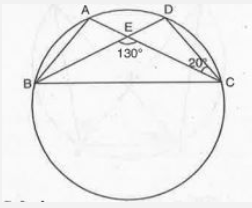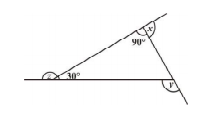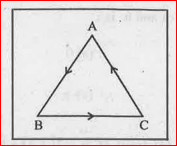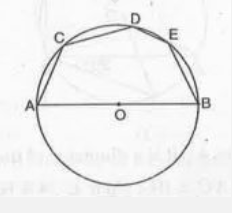Complete Solutions to Exercise of chapter Circles of Class 9 book with complete answers and questions
| Class 9 | MATHS |
| Chapter | Circles |
| MBD | Exercise |
| Number Of Questions | 94 |
| Academic Year | 2023-24 |
The centre of a circle lies in .............. of the circle.
View SolutionA point, whose distance from the centre of a circle is greater than its radius lies in .................. Of the circle.
View SolutionThe longest chord of a circle is a ........... of the circle.
View SolutionAn arc is a ........... When its ends are the ends of a diameter.
View SolutionSegment of a circle is the region between an arc and ........... of the circle.
View SolutionA circle divides the plane, on which it lies, in ............. parts.
View Solution(True/ False) Line segment joining the centre to any point on the circle is a radius of the circle.
View Solution(True/ False) A circle has only finite number of equal chords.
View Solution(True/ False) If a circle is divided into three equal arcs each is a major arc.
View Solution(True/ False) A chord, which is twice as long as its radius is a diameter of the circle.
View Solution(True/ False) Sector is the region between the chord and its corresponding arc.
View Solution(True/ False) A circle is a plane figure.
View SolutionEqual chords of a circle subtend equal angles at the centre.
View SolutionIf the angles subtended by the chords of a circle at the centre of the circle are equal, then the chords are equal.
View SolutionRecall that two circles are congruent if they have the same radii. Prove that equal chords of congruent circles subtend equal angles at their centres.
View SolutionProve that if chords of congruent circlessubtend equal angles at their centres, then the chords are equal.
View SolutionFill in the blanks:

View SolutionFind the angles formed at the centre of the circle by sides of a regular circular hexagon.
View SolutionThe angle formed by the sides of a circular regular polygon at its centre is `36^@`. Find the number of sides of polygon.
View SolutionThe angle formed by the side of a regular polygon at its centre is `45^@`. Name the polygon.
View SolutionThe perpendicular from the centre of a circle to a chord bisects the chord.
View SolutionThe line joining the centre of a circle to the mid-point of a chord is perpendicular to the chord.
View SolutionThere is one and only one circle passing through three non-collinear points.
View SolutionDraw different pairs of circles. How many points does each pair have in common ? What is the maximum number of common points ?
View SolutionSuppose you are given a circle. Give a construction to find its centre.
View SolutionIf two circles intersect at two points, prove that their centres lie on the perpendicular bisector of the common chord.
View SolutionThe length of a chord of circle of radius 10 cm is 12 cm. Determine the distance of the chord from the centre.
View SolutionThe length of a chord of a circle is 4 cm. If its perpendicular distance from the centre is 1.5 cm, determine the radius of the circle.
View SolutionThe radius of the circle is 5 cm and distance of the chord from the centre of the circle is 4 cm. Find the length.
View SolutionFind the length of a chord which is at a distance of 24 cm from the centre of a circle whose diameter is 50 cm.
View SolutionTwo points A and B are 16 cm apart. A circle with radius 17 cm is drawn to pass through these points. Find the distance of AB from the centre of the circle.
View SolutionIf the length of a chord of a circle at a distance of 5 cm from the centre of a circle is 24 cm, find the radius of the circle.
View SolutionA chord 6 cm long is drawn in a circle with a diameter equal to 10 cm. Find its perpendicular distance from the centre.
View SolutionIf the length of a chord of a circle at a distance of 24 cm from the centre of a circle is 36 cm, find the length of the greatest chord of the circle.
View SolutionAB and CD are two chords of a circle such that AB = 6 cm, CD = 12 cm and AB is parallel to CD. The distance between AB and CD is 3 cm. Find the radius of the circle.
View SolutionPQ and RS are two parallel chords of a circle whose centre is O and radius is 10 cm. If PQ = 16 cm and RS = 12 cm, find the distance between PQ and RS, if they lie on the same side of the centre O.
View SolutionPQ and RS are two parallel chords of a circle whose centre is O and radius is 10 cm. If PQ = 16 cm and RS = 12 cm, find the distance between PQ and RS, if they lie on the opposite side of the centre O.
View SolutionIn a circle of radius 25 cm, the lengths of parallel chords AB and CD are 14 cm and 48 cm respectively. Find the maximum distance between two chords and determine which chord is nearer to the centre.
View SolutionProve that a st. line cannot cut a circle in more than two points.
View SolutionTwo chords PQ and RS of a circle are parallel to each other and AB is the perpendicular bisector of PQ. Without using any construction, prove that AB bisects RS.
View SolutionEqual chords of a circle (or of congruent circles) are equidistant from the centre (or corresponding centres).
View SolutionChords of a circle (or of congruent circles), which are equidistant from the centre (or from the corresponding centres) are equal.
View SolutionTwo circles of radii 5 cm and 3 cm intersect at two points and the distance between their centres is 4 cm. Find the length of the common chord.
View SolutionIf two equal chords of a circle intersect within the circle, prove that the segments of one chord are equal to corresponding segments of the other chord.
View SolutionIf two equal chords of a circle intersect within the circle, prove that the line joining the point of intersection to the centre makes equal angles with the chord.
View SolutionIf a line intersects two concentric circles (circles with the same centre) with centre O at A, B, C and D, prove that AB = CD
View SolutionThree girls Reshma, Salma and Mandip are standing on a circle of radius 5 m drawn in a park. Reshma throws a ball to Salma, Salma to Mandip, Mandip to Reshma. If the distance between Reshma and Salma and between Salma and Mandip is 6 m each, what is the distance between Reshma and Mandip ?
View SolutionA circular park of radius 20 m is situated in a colony. Three boys Ankur, Syed and David are sitting at equal distance on its boundary each having a toy telephone in his hands to talk each other. Find the length of the string of each phone.
View SolutionIf two equal chords intersect each other, then the bisector of the angle between them pass through the centre.
View SolutionDraw less than ogive curve.

View SolutionFind the locus of the middle points of equal chords of a circle.
View SolutionFind the locus of the middle points of the parallel chords of a circle.
View SolutionWhat is the value of `sina` .
 .
.
View SolutionProve that a diameter of a circle which bisects a chord of the circle, also bisects the angles subtended by the chord at the centre of the circle.
View SolutionFactorise the Following
`x^2+8x+16`
View SolutionIn a circle of radius 5 cm, AB and AC are two chords, such that AB = AC = 6 cm. Find the length of the chord BC.
View SolutionIn a circle of radius 20 cm, AB and AC are two chords such that AB = AC =`8sqrt5cm`. Find the length of the chord BC.
View SolutionIf the angles subtended by the chords of a circle at the centre of the circle are equal, then the chords are equal.
View SolutionFactorise the following
`x^2-7x+12`
View SolutionProve that angle in a semi-circle is right angle.
View SolutionIf a line segment joining two points subtends equal angles at two other points lying on the same side of the line containing the segment, the four points are concyclic (i.e. lie on the same circle).
View SolutionA chord of a circle is equal to the radius of the circle. Find the angle subtended by the chord on a point on the minor arc and also at a point on the major arc.
View SolutionIn fig.
 , A, B, C, D are four points on a circle. AC and BD intersect at a point E such that `/_BEC = 130^@` and `/_ECD = 20^@`. Find `/_BAC`.
, A, B, C, D are four points on a circle. AC and BD intersect at a point E such that `/_BEC = 130^@` and `/_ECD = 20^@`. Find `/_BAC`.
View SolutionABCD is a cyclic quadrilateral whose diagonals intersect at a point E. `/_DBC = 70^@`, `/_BAC is 30^@`, find `/_BCD`. Futher, if AB = BC, find `/_ECD`.
View SolutionIf diagonals of a cyclic quadrilateral are diameters of the circle through the vertices of the quadrilateral, prove that it is a rectangle.
View SolutionIf the non-parallel sides of a trapezium are equal, prove that it is cyclic.
View SolutionIdentify (a),(b) and (c)

View SolutionIf circles are drawn taking two sides of a triangle as diameters, prove that the point of intersection of these circles lie on the third side.
View SolutionABC and ADC are two right triangles with common hypotenuse AC. Prove that `/_CAD = `/_CBD`.
View SolutionProve that a cyclic parallelogram is a rectangle.
View SolutionABCD is a cyclic quadrilateral. If `/_BCD = 100^@` and `/_ABD = 30^@`, find `/_BAD`.
View SolutionABCD is a cyclic quadrilateral in which `/_DBC = 80^@` and `/_BAC = 40^@`. Find `/_BCD`.
View SolutionFind x+y+z

View SolutionFind x+y+z

View SolutionMatch the following :
 .
.
View SolutionIn `DeltaABC` which is not true :

View SolutionFind x+y+z

View SolutionThe lengths of two parallel chords of a circle are 6 cm and 8 cm. If the smaller chord is at a distance of 4 cm from the centre, what is the distance of the other chord from the centre ?
View SolutionLet vertex of an angle ABC be located outside a circle and let the sides of the angle intersect chords AD and CE with the circle. Prove that `/_ABC` is equal to half the difference of the angles subtended by the chords AC and DE at the centre.
View SolutionBisectors of angles A, B and C of a triangle ABC intersect its circumcircle at D, E and F respectively. Prove that angles of the triangle are `90^@-A/2,90^@-B/2` and `90^@-C/2` respectively.
View SolutionTwo congruent circles intersect each other at points A and B. Through A any line segment PAQ is drawn so that P, Q lie on the two circles. Prove that BP = BQ.
View SolutionIn any triangle ABC, if the angle bisector of `/_A` and perpendicular bisector of BC intersect, prove that they intersect on the circumcircle of the triangle ABC.
View SolutionFind x+y+z

View SolutionFind x+y+z

View Solution(True/ False) Two chords AB and CD of a circle are each at distances 4 cm from the centre. Then AB = CD.
View Solution(True/ False) Two chords AB and AC of a circle with centre O are on the opposite side of OA. Then `/_OAB = /_OAC`.
View Solution(True/ False) Two congruent circles with centres O and O' intersect at two points A and B. Then `/_AOB = /_AO'B`.
View SolutionThrough three collinear points a circle can be drawn.
View Solution(True/ False) A circle of radius 3 cm can be drawn through two points A, B such that AB = 6 cm.
View Solution(True/ False) If AOB is a diameter of a circle and C is a point on the circle, then `AC^2 + BC^2 - AB^2`.
View Solution(True/ False) ABCD is a cyclic quadrilateral such that `/_A = 90^@`, `/_B = 70^2`, `/_C = 95^@` and `/_D = 105^2`.
View Solution(True/ False) If A, B, C, D are four points such that `/_BAC = 30^@` and `/_BDC = 60^@`, then D is the centre of the circle through A, B and C.
View Solution(True/ False) If A, B, C and D are four points such that `/_BAC = 45^@` and `/_BDC = 45^@`, then A, B, C, D are concyclic.
View Solution(True/ False) In Fig.

If AOB, is a diameter and `/_ADC = 120^@`, then `/_CAB = 30^@`.
View Solution
Exercise questions and complete solutions for chapter Circles of MBD of Class 9